Wildlife at BBG
Many native plants have coevolved with wildlife and provide important sources of food and shelter. As you explore BBG you may see some of the wildlife that call the Garden home including the birds, mammals, and insects below.
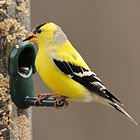
Photo by JanetandPhil.
American Goldfinch
(Carduelis tristis)
In fall and winter, American goldfinches use purple coneflower as a food source and enjoy the seeds housed inside the pods. These small birds also use stands of holly as important fast food stops during migration. Listen for the per-chick-o-ree call that this bird makes.
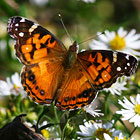
Photo by Bill Benish.
American Painted Lady Butterfly
(Vanessa virginiensis)
Migratory American painted lady butterflies pass through the northeastern United States en route to Canada in May. To fuel this tremendous journey, these voracious nectarfeeders (and great pollinators) feast on plants like bee balm.

Photo by David Hofmann.
American Robin
(Turdus migratorius)
American robins are best identified by their red breasts, white eye rings, and yellow beaks. Look for them hopping along the ground seeking invertebrates and fruit or among the branches of a hackberry tree. Robins are among the first songbirds to start singing in the morning and some of the last chirping as evening falls.

Photo by David Walenga.
Baltimore Checkerspot Butterfly
(Euphydryas phaeton)
Baltimore checkerspot butterflies prefer boggy environments, where they lay eggs exclusively on the underside of white turtlehead leaves. When the caterpillars hatch, they move to the tips of leaves and feed together in a nest of silk spun for protection from predators.
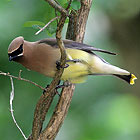
Photo by Eddie Callaway.
Cedar Waxwing
(Bombycilla cedrorum)
Cedar waxwings have an exceptional ability to survive off fruit alone for months at a time, occasionally from hackberry trees or the brilliant red berries of American holly. They can be found in the summer months gulping down berries whole without even spitting out the seeds. Their fruit obsession can reach such a fever pitch that cedar waxwings are known to consume past-ripe and fermented fruits, causing some of them to fall drunk or even die.

Photo by sankax.
Common Eastern Bumble Bee
(Bombus impatiens)
Bumble bees are known for their unusual “buzz” method of pollination, by which their vibrations shake pollen free from flowers, making pollination more efficient. The common eastern bumble bee is the primary pollinator of the white turtlehead and is also responsible for pollinating many vegetables in New York State, especially pumpkin.
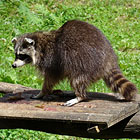
Photo by zooadmin.
Common Raccoon
(Procyon lotor)
The raccoon is usually active at night and spends its days sleeping in tree cavities. It is an omnivore and will eat insects, frogs, fish, and small mammals, as well as fruit like the native fox grape. Raccoons are fast runners (up to 15 mph) and excellent swimmers, and they are known for their superb night vision and acute hearing.

Photo by Gerry Stewart.
Eastern Chipmunk
(Tamias striatus)
The eastern chipmunk gathers acorns and other seeds from many trees, including oaks, maples, and flowering dogwoods. It packs the seeds into its cheeks and brings them back to its underground burrow to store for winter. Some of these cached seeds will sprout into new trees. Eastern chipmunks also munch on insects that live in and around trees, such as katydids, cicadas, and beetles.

Photo by Gerry Stewart.
Eastern Cottontail Rabbit
(Sylvilagus floridanus)
The eastern cottontail rabbit eats a variety of plants, but in the winter it depends on the woody twigs and bark of birch, oak, dogwood, and maple trees. This native rabbit can leap up to 15 feet in a single bound. It will sometimes stand on its hind feet to watch for predators, and if chased, it will often leap from side to side to break its scent trail.
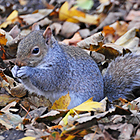
Photo by Steve Greaves.
Eastern Gray Squirrel
(Sciurus carolinensis)
Although oak acorns and other nuts are squirrels’ favorite food, they also eat the fruits, seeds, and flowers of a variety of other plants. The native eastern gray squirrel also uses its curved claws and expert climbing skills to climb deftly—and even hang upside down from branches—to collect nuts, berries, and seeds from trees like the box elder. Look for their large leafy nests nestled high in the boughs of tall trees.
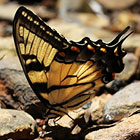
Photo by Lisa Brown.
Eastern Tiger Swallowtail Butterfly
(Papilio glaucus)
Eastern tiger swallowtail butterflies are known for their characteristic “tails” extending from their hindwings. This native butterfly sips nectar from a number of flowers, including the downy phlox. They are often found in the temperate deciduous forests of the Northeast. Caterpillars feed on the leaves of trees like cherry, birch, and ash, and adults consume nectar from bright-blossomed plants like the cardinal flower.
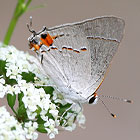
Photo by sankax.
Gray Hairstreak Butterfly
(Strymon melinus)
Clustered mountain-mint is a favorite nectar source for many butterflies, including the gray hairstreak. This butterfly is almost entirely gray with a yellow spot on its wings and a singular threadlike “tail” extending from each hindwing. As it ages, the caterpillar of the gray hairstreak changes its food preferences, moving from buds and flowers to the leaves of many kinds of plants.
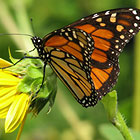
Photo by Lisa Brown.
Monarch Butterfly
(Danaus plexippus)
Monarch butterflies lay their eggs on milkweed, a plant toxic to most other animals. The caterpillars that hatch eat the milkweed and integrate the plant toxins into their own tissue, which makes the monarch distasteful to predators. The monarch is the only species of butterfly that migrates both north and south, a trip that spans several generations and as much as 3,000 miles each way.

Photo by Gerry Stewart.
Northern Cardinal
(Cardinalis cardinalis)
Cardinals are among the most colorful native birds in our region—during the gray days of winter, the male’s red plumage is a treat to behold as the bird feasts on the fruit of shining sumac. Common year-round east of the Rocky Mountains, these songbirds start serenading early in the morning, with a whistling tee-ew-tee-ew-tee-ew-tee-ew.
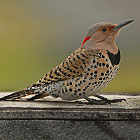
Photo by CleberBirds.
Northern Flicker
(Colaptes auratus)
With leopard-spotted bellies and tiger-striped backs and wings, northern flickers are not your everyday woodpecker. You can find flickers in an unexpected place: on the ground, foraging for ants and beetles. On occasion, you’ll catch one knocking away at a tree trunk or feeding on the fruit and seeds of a dogwood tree.

Photo by William Klos.
Northern Mockingbird
(Mimus polyglottos)
Many birds depend on the long-lasting red fruits of the winterberry, including our native northern mockingbird. Northern mockingbirds love to imitate other birds, animals, and even inanimate objects like car alarms. Because they tend to nest near houses and practice their noisy crooning late into the night, these birds have earned a bad reputation with some humans.
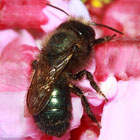
Photo by Sam Houston.
Orchard Bee
(Osmia lignaria)
Orchard bees, solitary bees native to our area, live and lay their eggs in soft, pithy plant stems like those of Joe-pye weed. They are efficient in aiding cross-pollination and visit a variety of trees, including goldenrods.
Female orchard bees can select the gender of the eggs they lay by fertilizing the egg—or not. Most of the eggs are fertilized and develop into females; the rest become males.
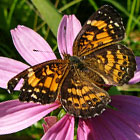
Photo by Gerry Stewart.
Pearl Crescent Butterfly
(Phyciodes tharos)
Often seen near water, pearl crescent butterflies depend on plants like bog aster, swamp milkweed, and dogbane for nectar, and in return they serve as pollinators. They are named for the light-colored, crescent-shaped markings on the underside of their hindwings.

Photo by JanetandPhil.
Periodical Cicada
(Magicicada septendecim)
Periodical cicadas live most of their lives underground as nymphs, sucking sap from trees such as the eastern redbud before emerging every 13 or 17 years to lay eggs. Native trees that coevolved with this insect usually suffer little damage from it.

Photo by Anthony Hennes.
Ruby-Throated Hummingbird
(Archilochus colubris)
The ruby-throated hummingbird is the only hummingbird species native to our area. This brilliantly iridescent pollinator consumes flower nectar, including that of the eastern redbud. The nectar’s high sugar content helps fuel the tiny bird’s spring migration from as far away as Central America.
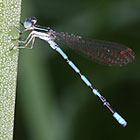
Photo by Anthony Zukoff.
Seepage Dancer Damselfly
(Argia bipunctulata)
Damselflies are commonly found in grasses and rushes near ponds. Their narrow bodies differ from those ofdragonflies in that they hold their wings above their heads.
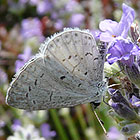
Photo by Valerie L.
Summer Azure Butterfly
(Celastrina neglecta)
Azure butterflies have pale powder-blue to silver wings tipped with a feathery fringe. The summer azure butterfly can be identified by its banded antennae, typically black and white. This common northeastern pollinator often sips the nectar of the sweet pepperbush’s flowers, and its caterpillars feed on the leaves.
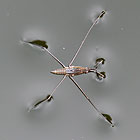
Photo by jaydot.
Water Strider
(Aquarius remigis)
The water strider has a light body and four long, wide-set legs that allow it to skate on the surface of the water of swamps. Its two short front legs are for grabbing prey; the middle legs push the insect forward; and the hind legs steer. The female water strider lays eggs at the water’s edge, usually on plant stems.
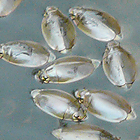
Photo by Dinesh Valke.
Whirligig Beetle
(Dineutus assimils)
Swamp and bog plants provide shelter, breeding grounds, and food for a variety of insect life, such as the native whirligig beetle. The beetle spins around on the surface of the water, an evasive action to confuse predators, as it scavenges for insects, algae, and decomposing plants. It has horizontally divided eyes that allow it to see above and below the surface of the water.

